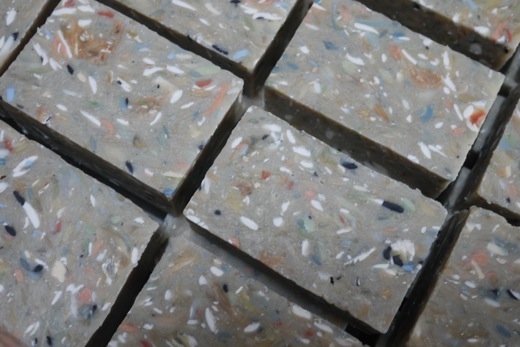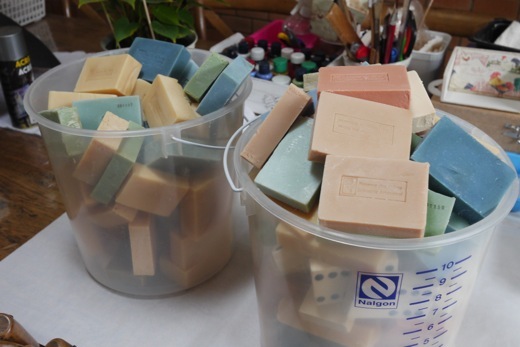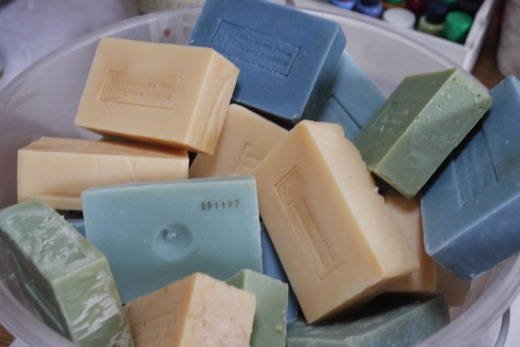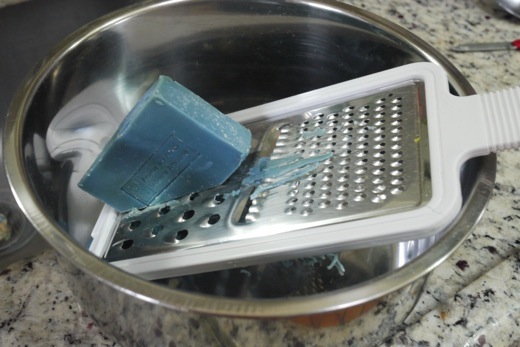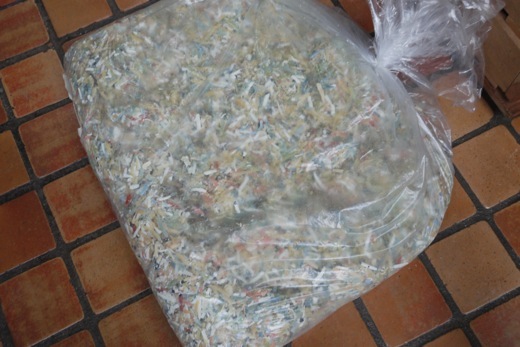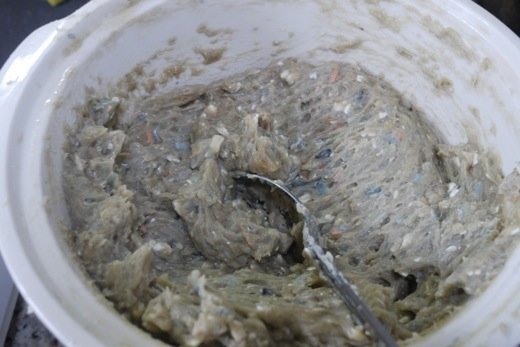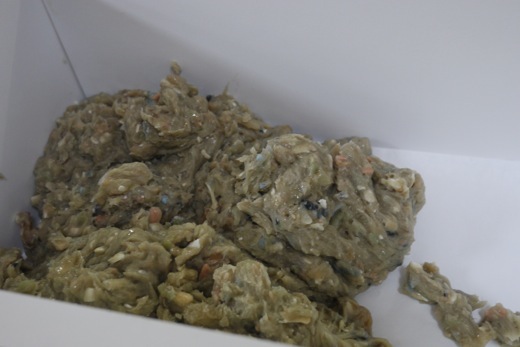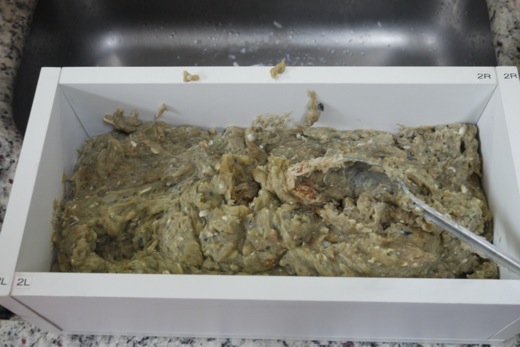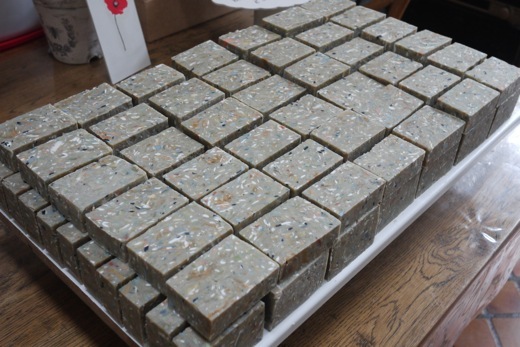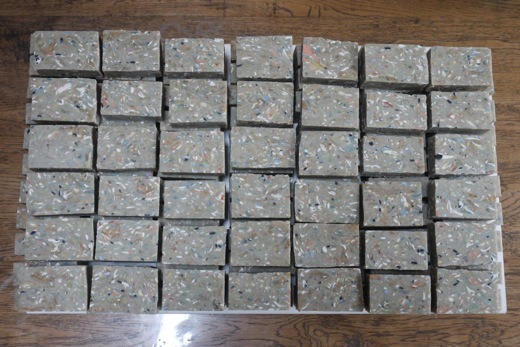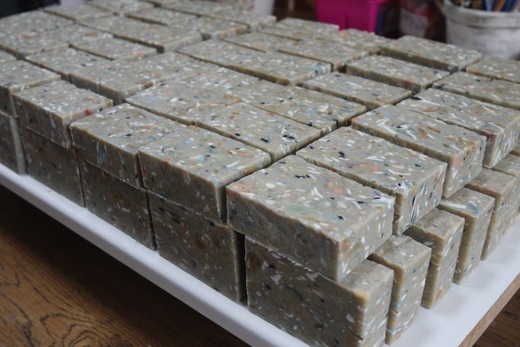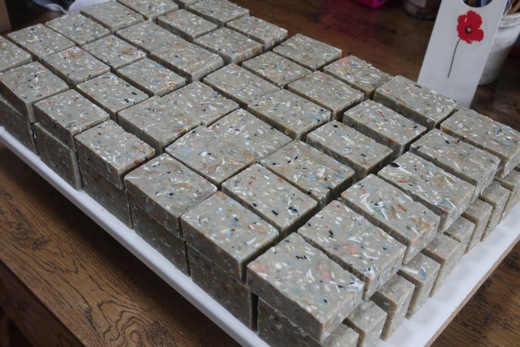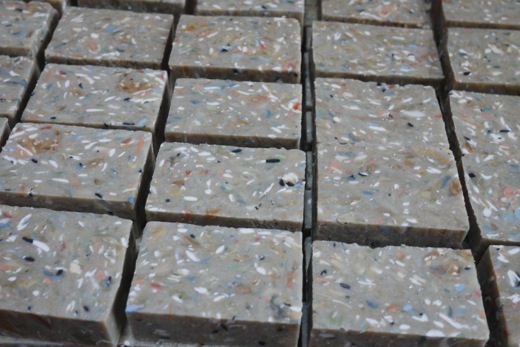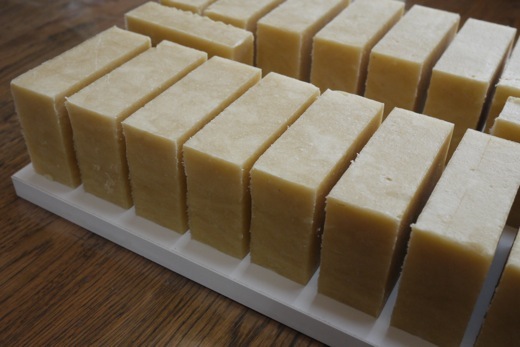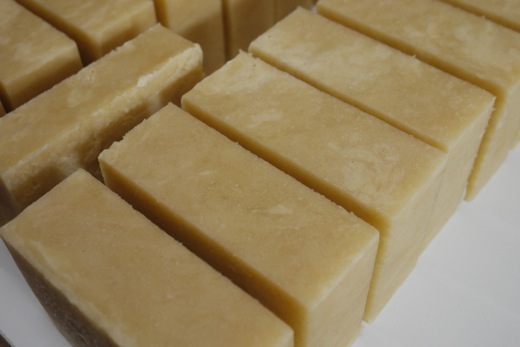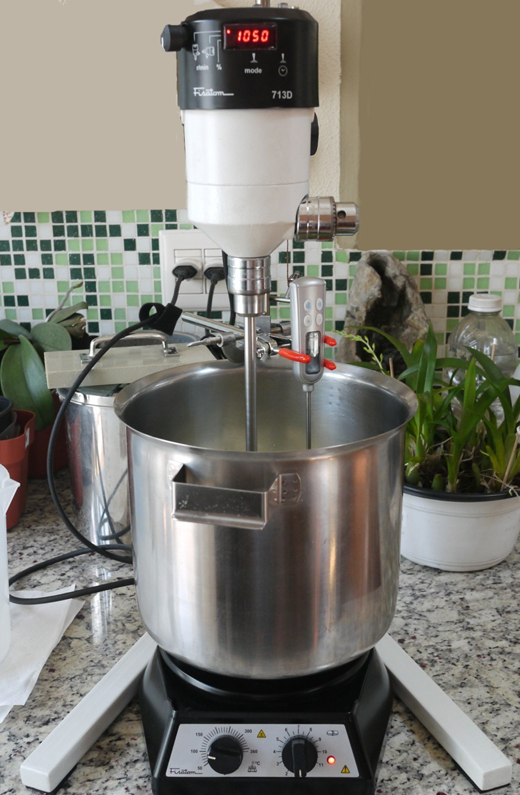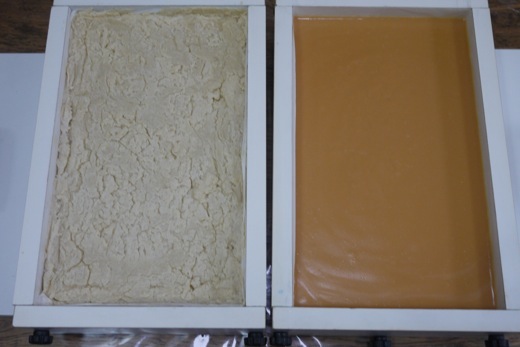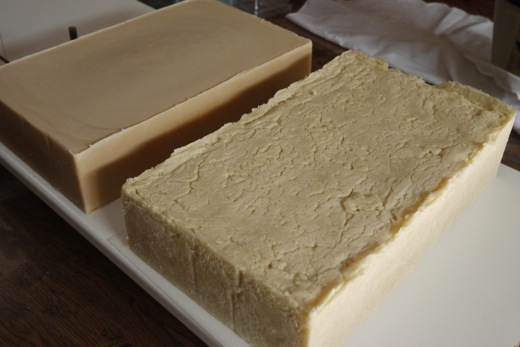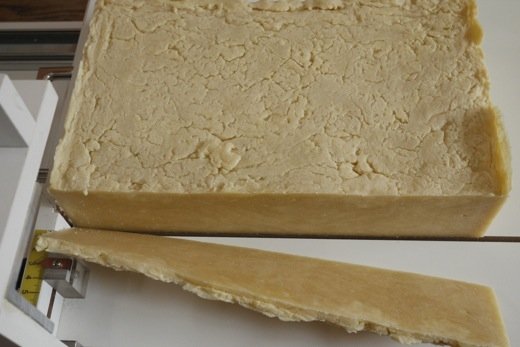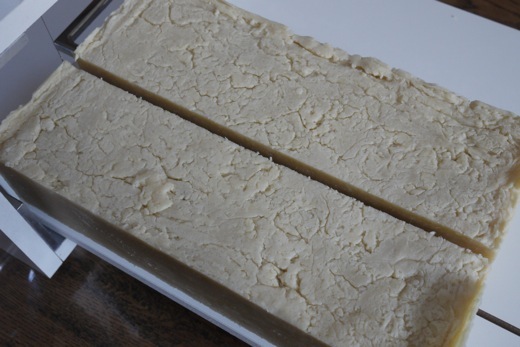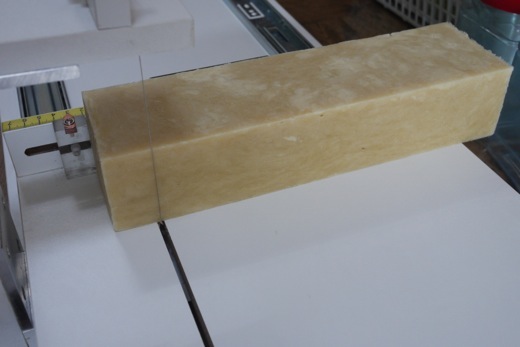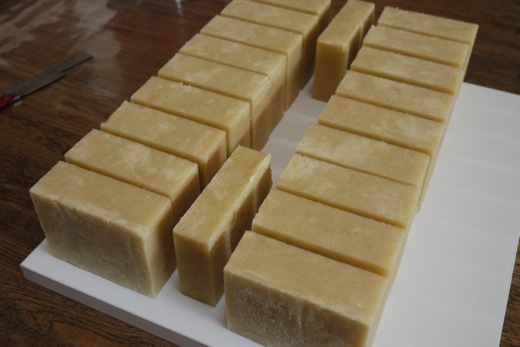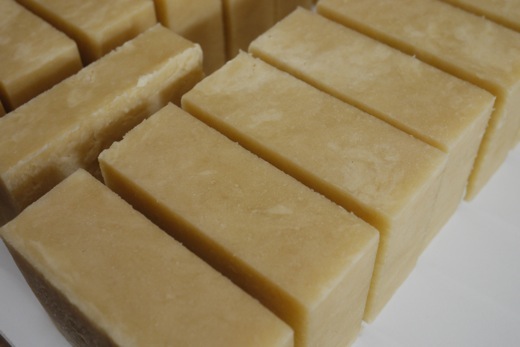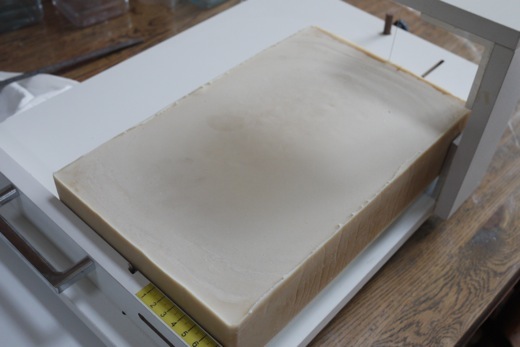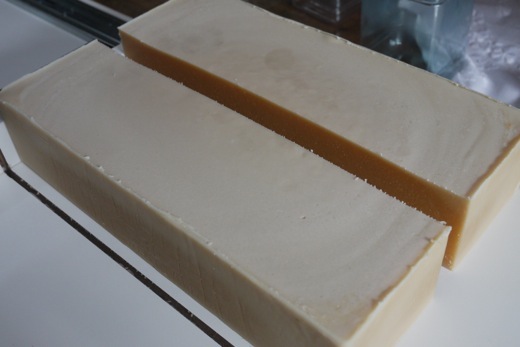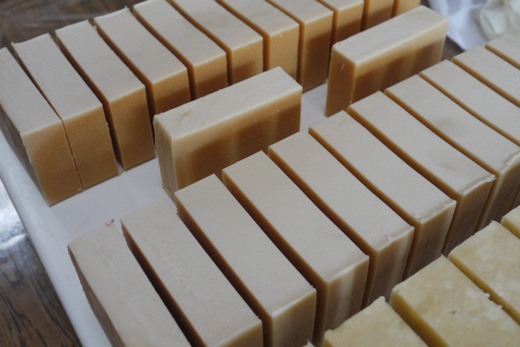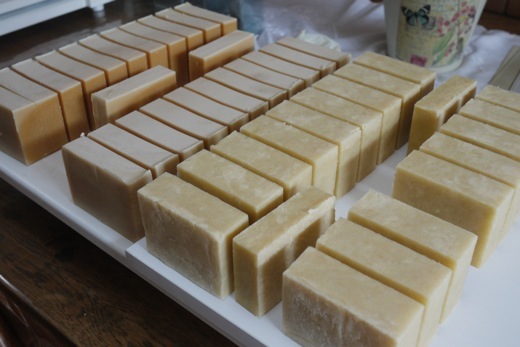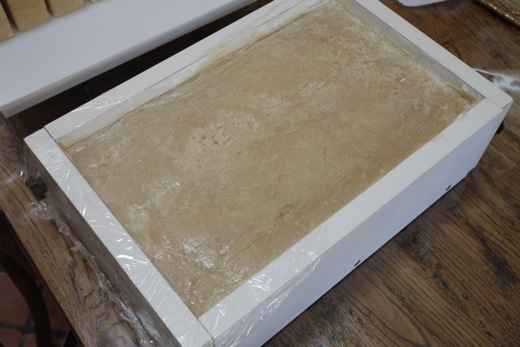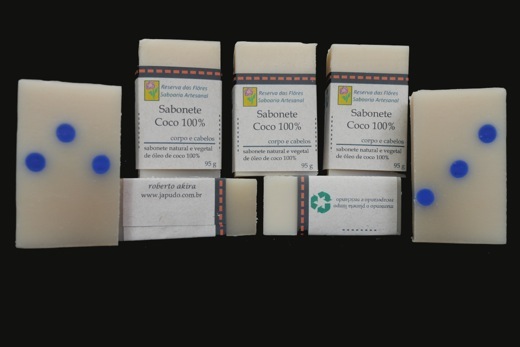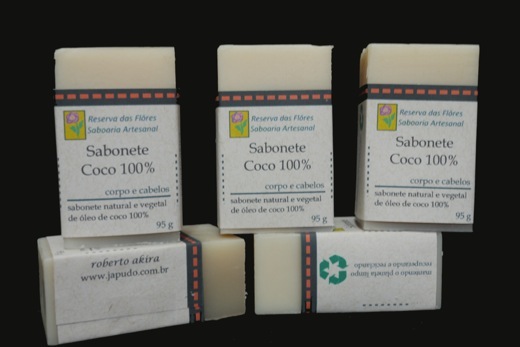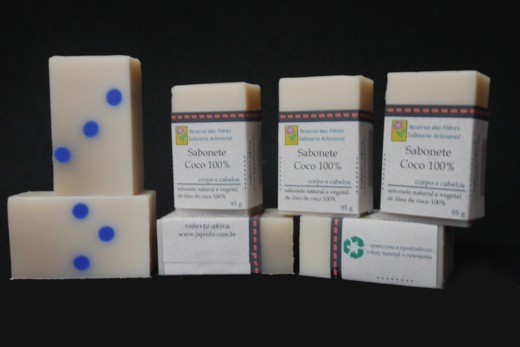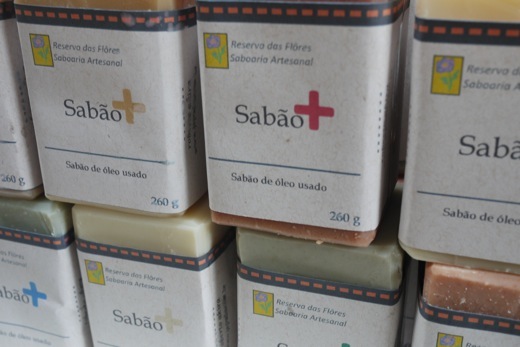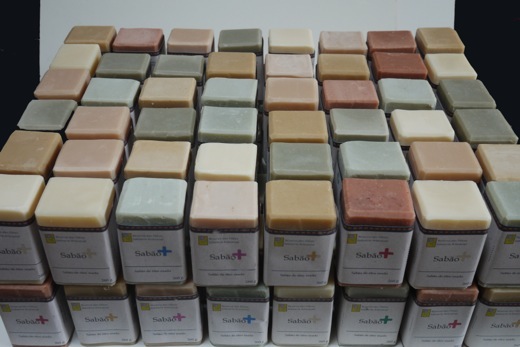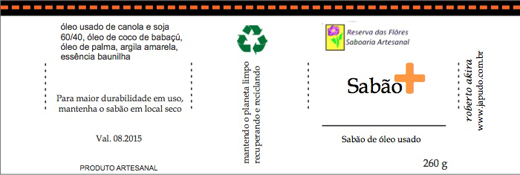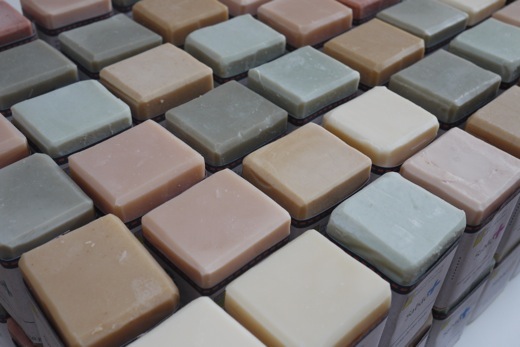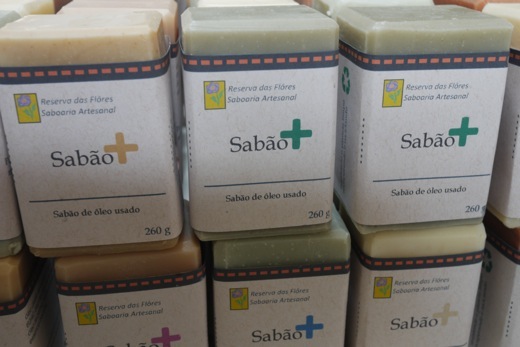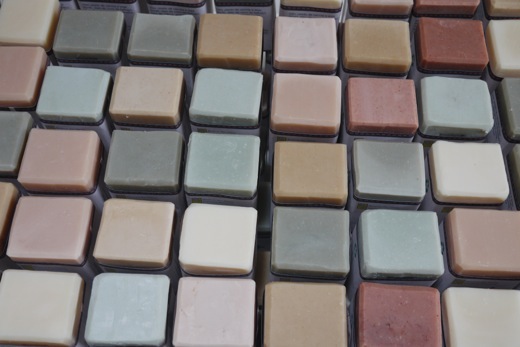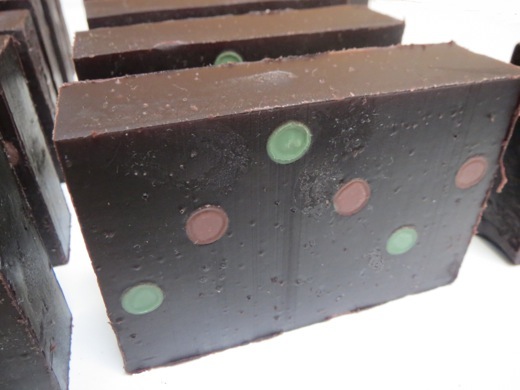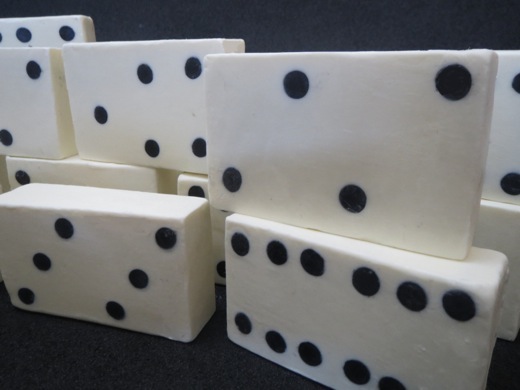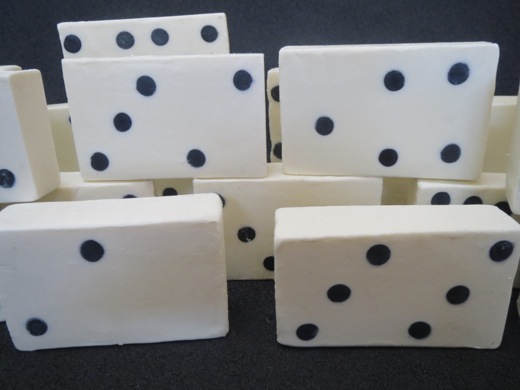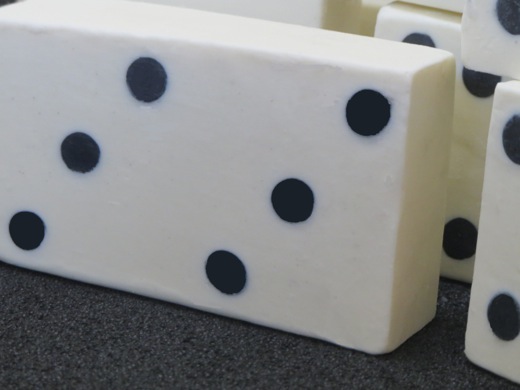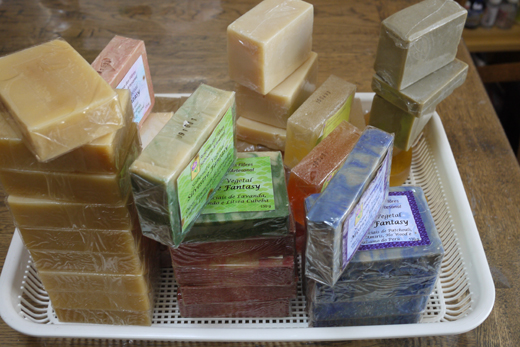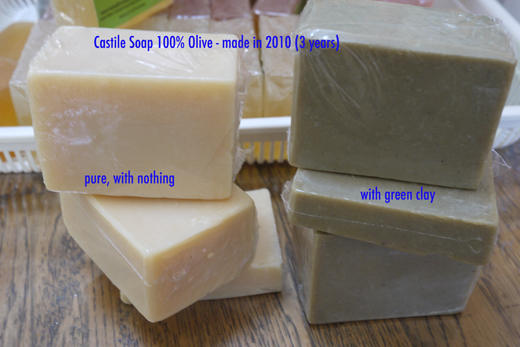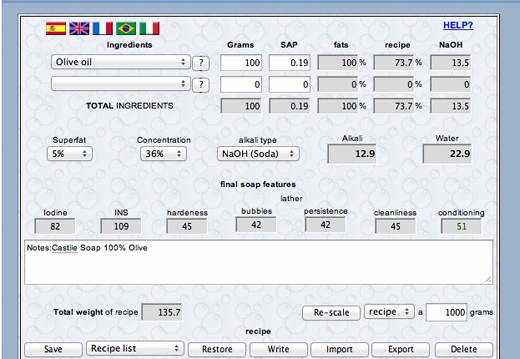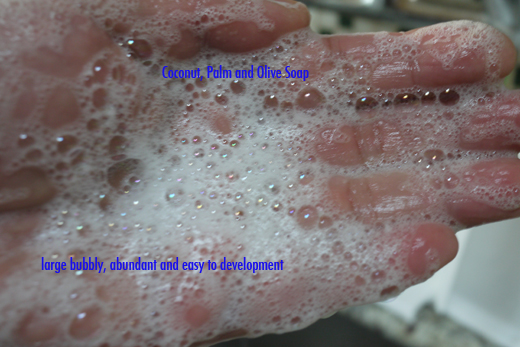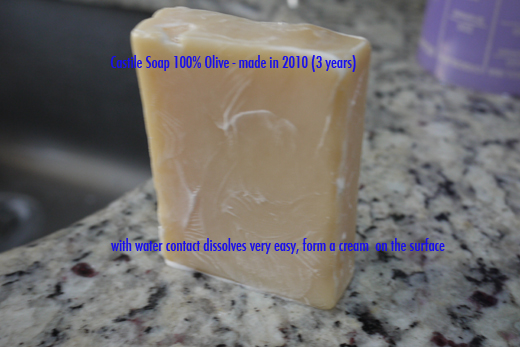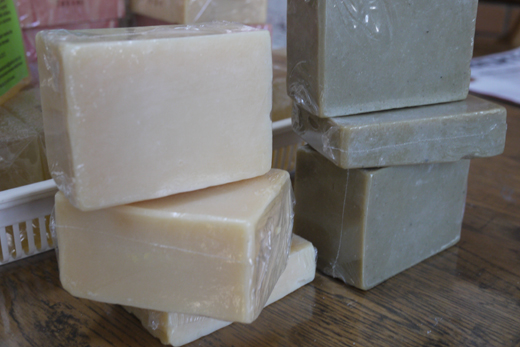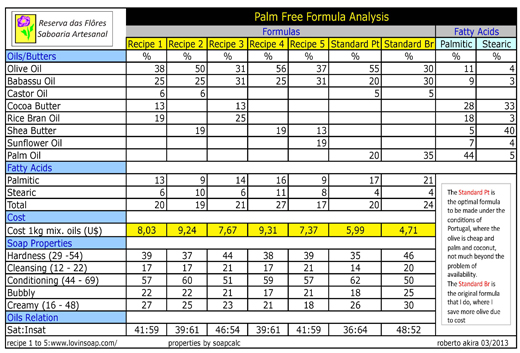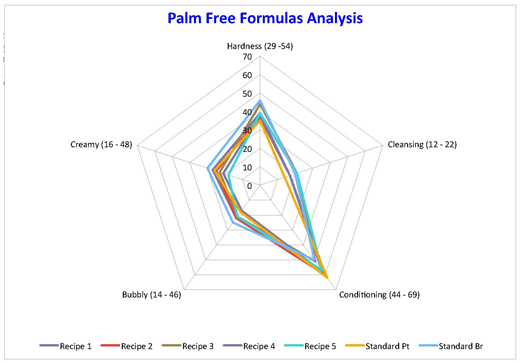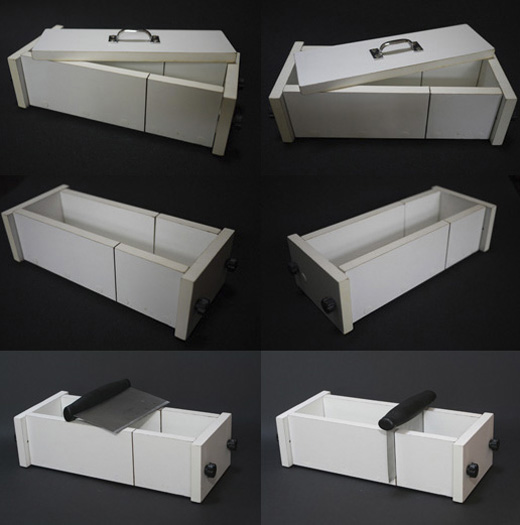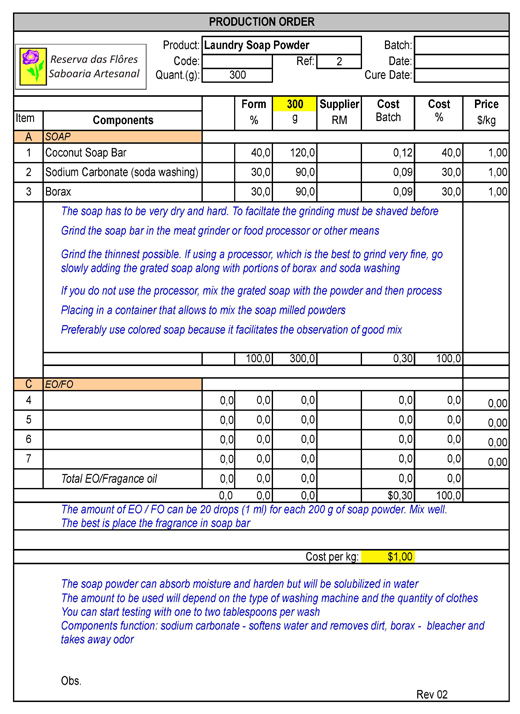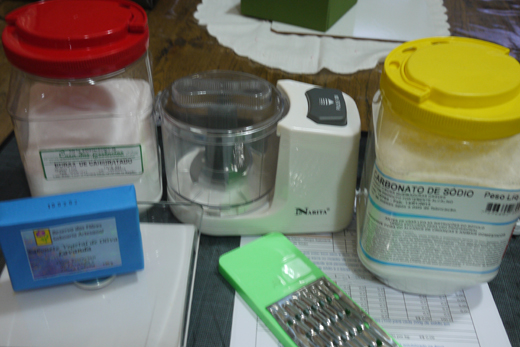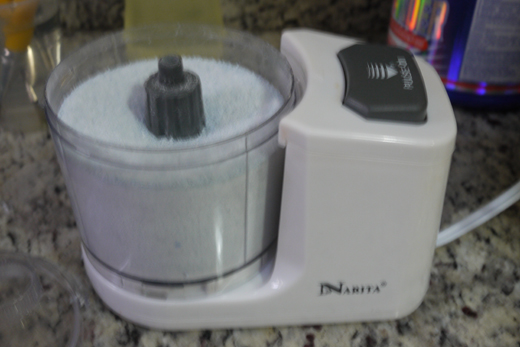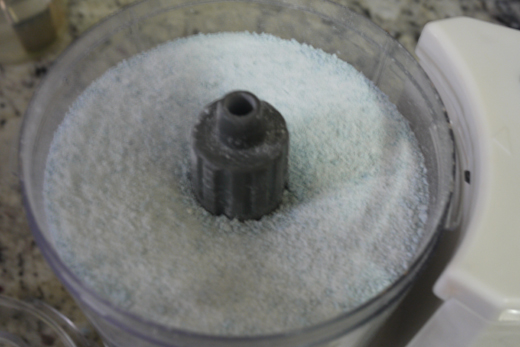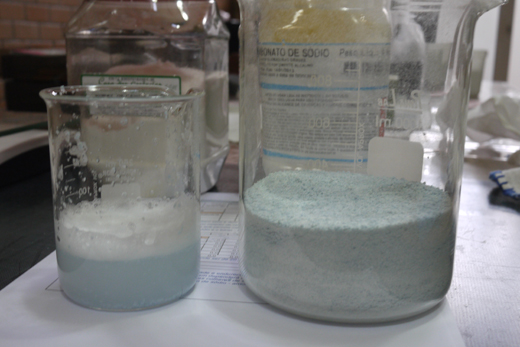In the classic shaving many prefer shaving soap to shaving cream. The shaving soap requires a little more work to load the brush and build the lather. This time spent is part of the ritual of the classic shaving and refers to the golden age of the great barber. Are still the main products of the centenary and fashionable London houses the 3Ts – Truefitt and Hill, GF Trumper and Taylor Of Old Bond Street. 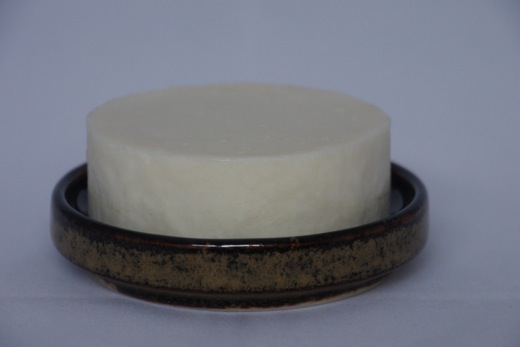 This container made of ceramics in Japan, serves to maintain the shaving soap bar in use.
This container made of ceramics in Japan, serves to maintain the shaving soap bar in use. 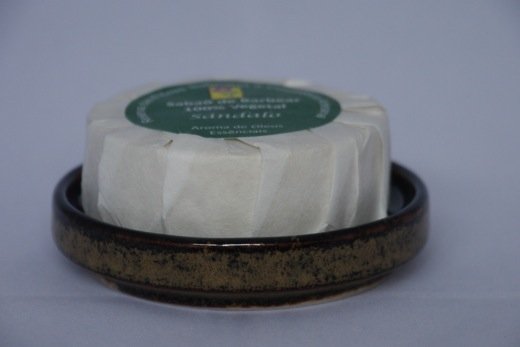
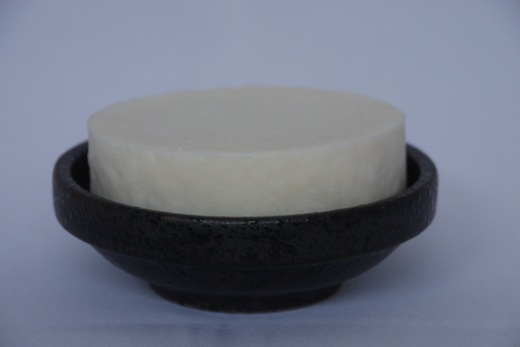 This is another option, a ceramic made in China more rustic look.
This is another option, a ceramic made in China more rustic look. 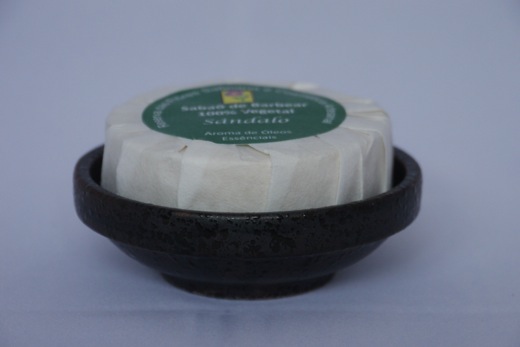
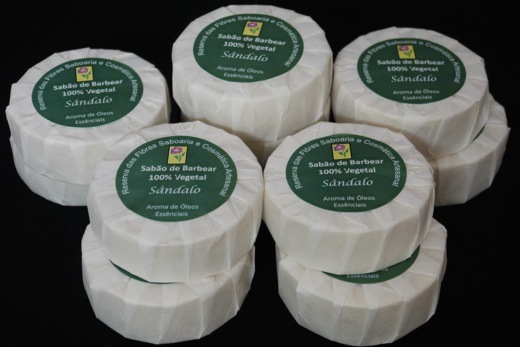
Arquivos da Categoria: Cold Process @en
Soap reuse/reprocessing – rebatch
Accumulated over time a lot of soaps that were leaning awaiting a destination, and now decided to make a reuse – rebatch and donate the soap for some institutions.
He had a box full of them, most packaged in cellophane made in 2009 that ended up not trading at the time I was selling soap, because I changed the formula to a harder soap and they ended up getting.
The amazing thing is that these soaps with almost 5 years, were all perfect, even with a sharp aroma of essential oils. I gathered these samples retention of batches produced, some of the tests I ran, totaling 13 kg of soap.
First step is to break up the soap bars to facilitate melting. I tried with a electric meat grinder but did not work because most of this soap has a predominant, although very dry, composition of unsaturated oils (olive) and so sticky that does not flow through the grinder.
The alternative was to manually grate, a work bordering on insanity that took almost a whole day to grate bar for bars, 13kg of soap.
I used a slow-cooker (crock pot) to melt and fuse the soap into a single mass. I made 2,5 kg batch with addition of 10% water.
As the grated soap occupies too much volume each batch of 2.5 kg was born at three stages, taking approx. 3 hours each processing. The last load of shavings was allowed to melt partially to give this effect of colored chips.
Finally after almost a day scraping the soaps and another 15 hours of rebatching work, here are the 100 bars of soap 90g reprocessed.
Cutting benzoim soap made by Hot Process Continuous Stirring
Here the video that shows how the benzoim soap was cut. Soap made by Hot Process Continuous Stirring – HPCS:
Hot Process Continuous Stirring – HPCS
In the small town of Fontevraud L’Abbaye in the Loire Valley in France, since 1974 there is a renowned handmade soapmaker, Savonnerie Martin de Candre. Since its founding 40 years, Martin de Candre soap manufacture (MdC) is dedicated to producing excellent quality handmade soap products, as they say, using the classic process of Marseilles soap.
The soap (cream) shaving of Martin de Candre is considered the best in the world, they have a line of Marseille soap (for cleaning) with olive, coconut and palm, a line call huile de palme that is made with olive , coconut and palm oil and a third, huile d’olive, only with olive and coconut.
All these products have a premium price ranging 9 to 16 euros for soaps bars and shaving soap can cost 23 euros one container of 50 grams.
They claim that make the process of Marseilles soap which is a full boiling process where the soap is rinsed with salted water and glycerin is removed. In reality MdC makes a fairly conventional handmade hot process, which uses a mechanical stirrer to stir the mass during saponification and the lot size is less than 25 kg. This can be seen in the few photos on their website and also a video report produced by a French TV.
But what caught my attention was the procedure them to dry for eight months the soap bars and for 5 months the shaving soap! Intriguing because the hot process soap has saponified out and therefore safe and drying 15 days is enough to have the necessary hardness for lasting use. A soap made by Cold Process is ready for use in about 20 days. Here comes the question, why make a process more complex, lengthy and expensive process that is hot, if I can make cold process much simpler, faster and cheaper? After leaving it for 8 months a soap made by hot or cold, theoretically they would have the same performance. It is clear that the hot process has the advantage of being able to incorporate sensitive components after alkaline saponification, which preserves these components, in which process cold is not possible.
I decided to design a test to compare the properties of a soap made by cold process and the same made by hot process and also compare the influence it has drying time in soap performance in both cases.
Hot Process with Continuous Stirring – HPCS
A handmade hot processs is normally done using as source of heating a double boiler or an electric slow cooker (crock pot), and the mass is homogenized manually from time to time to enable a comprehensive saponification.
To keep the process more akin to the Martin de Candre hot process, I designed a system called Hot Process Continuous Stirring – HPCS. Obviously not is an innovation, but in the artisanal scale not seen anyone use a similar system.
Thus, a comparative test between soaps produced by two distinct processes, eventually drifting to the development of a third way to do a hot process that is the HPCS.
This is the setup of the equipment to do the HPCS – an electric heater (this is a laboratory magnetic stirrer), a mechanical stirrer (used with digital speed control) and a digital thermometer.
Here’s a video I made showing the HPCS to make benzoim soap (12 minutes):
http://www.youtube.com/watch?v=aYyWmYJ51EY
Soaps Testing
The Martin Candre in your palm line has a honey soap and a benzoim (tonkinense Styrax) soap, and were made simlilar these for testing. The oil soap composition was: olive / palm kernel / palm – 60/25/15, SF 5% and lye concentration of 30%. The comparative test will be done with the honey and the benzoim was done to confirm and optimize the process HPCS. You can not make a regular cold process with benzoim because of the need to dilute the benzoim oil resin with ethanol, which would give the defect of seizing on mass.
On the left the soap made with honey HPCS, the other by conventional cold process. The color is dark in the cold process due to carbonization of the sugar honey by lye.
The two blocks of honey soaps , 3.5kg.
Cut surface finish of the honey soap by hot process with continuous stirring using Flex Cutter.
The two bars finished in the dimensions of 305 x 80 x 60 mm.
Cutting individual bars using Flex Cutter.
Cut with precision Cutter Flex.
All individual bars 80x60x30 mm, 135 grams.
Cut the block of honey soap made with cold process.
All bars of honey soap CP, 90x60x25 mm, 130 grams.
The two soaps will be used in the comparison between CP and HP.
Benzoim soap made by Hot Process Continuous Stirring – HPCS
This soap was made to confirm and improve the HPAC process.

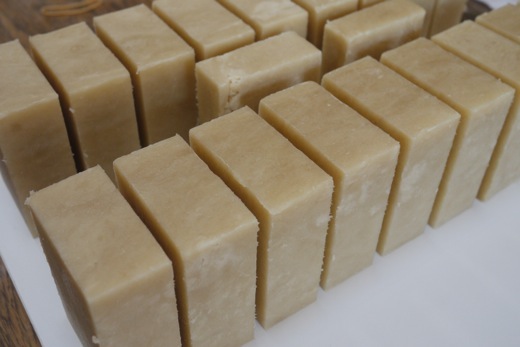
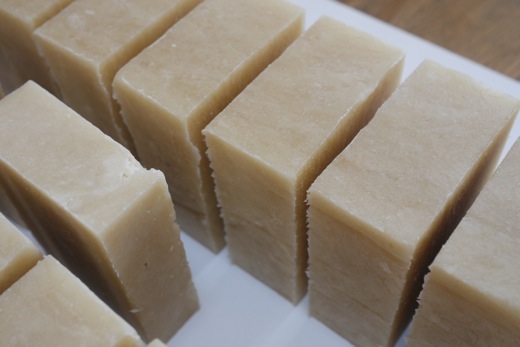 ———————————————————————————————-
———————————————————————————————-
Savonnerie Martin de Candre: http://savonnerie-martin-de-candre.com/fr/
100% Coconut soap body & bath – ready
After 3 weeks drying was completed the 100% coconut soap for use in the body. The question we had was whether this soap superfatting 20% to make him suitable for use in the body, neutralizing a possible effect of dry skin, was a really good soap for bath and body. I’ve used three days followed this soap in the shower and I can say that it is amazing, one the best soap I’ve ever made / used! It does not dry the skin, it leaves a feeling of treated skin with a cream or oil, velvety very nice. That’s because 20% of excess coconut oil is really a true superfatting. All other properties are excellent, has great hardness, and the bubble is fantastic! The essential oil massoia is very good, has a fabulous power of scent, smell fresh coconut! Each skin is a skin and not generalize, for me was very good, really enjoyed, you might not go so well in others, but in any case recommend making this soap.
Used cooking oil soaps – ready!
Chocolate soap with mint and cocoa drops

 Soap formulated with palm oil / babassu oil / olive oil / castor oil / cocoa butter – 30/30/30/5/5 with SF (superfating) 5%, lye concentration of 30%, 13 % (o/o) of solid chocolate bars with 70% cocoa and 0.7% (o/o) of 100% cocoa powder. The soap was decorated with the technique of straws with green pigment of chromium and titanium dioxide for green spots and aroma of 3% (o/o) of essential oil of peppermint. In the cocoa colored spots the red iron oxide was tinting with black iron oxide and titanium dioxide, and to give aroma, was used sweet orange essential oil 2% (o/o).
Soap formulated with palm oil / babassu oil / olive oil / castor oil / cocoa butter – 30/30/30/5/5 with SF (superfating) 5%, lye concentration of 30%, 13 % (o/o) of solid chocolate bars with 70% cocoa and 0.7% (o/o) of 100% cocoa powder. The soap was decorated with the technique of straws with green pigment of chromium and titanium dioxide for green spots and aroma of 3% (o/o) of essential oil of peppermint. In the cocoa colored spots the red iron oxide was tinting with black iron oxide and titanium dioxide, and to give aroma, was used sweet orange essential oil 2% (o/o).
 Was made this device that eliminates the use of modeling clay to hold the straws. It measures the mold and is attached to the bottom of the mold. The wells are 8.5 mm in diameter to hold 8 mm straws and has a depth of 12 mm.
Was made this device that eliminates the use of modeling clay to hold the straws. It measures the mold and is attached to the bottom of the mold. The wells are 8.5 mm in diameter to hold 8 mm straws and has a depth of 12 mm.
 This mold was especially designed to allow to do 6 x 9 cm bars from 6 up to 24 bars (130g) using the technique of pipes.
This mold was especially designed to allow to do 6 x 9 cm bars from 6 up to 24 bars (130g) using the technique of pipes.
 As this decoration was not used all the wells, those that are not used have been closed with tape (in blue).
As this decoration was not used all the wells, those that are not used have been closed with tape (in blue).
 The chocolate is mixed with oils and cocoa butter and melted in the microwave.
The chocolate is mixed with oils and cocoa butter and melted in the microwave.
 To use the technique of straws is important to leave a trace very light, which is added cocoa powder.
To use the technique of straws is important to leave a trace very light, which is added cocoa powder.
 With the light trace is possible and even the mass of soap in the mold with the straws. The mold is in its maximum capacity as the mass is for 24 bars.
With the light trace is possible and even the mass of soap in the mold with the straws. The mold is in its maximum capacity as the mass is for 24 bars.
 There was the formation of full gel and the surface temperature was 42 º C and after 6 hours the straws were removed when the temperature dropped to 32 º C.
There was the formation of full gel and the surface temperature was 42 º C and after 6 hours the straws were removed when the temperature dropped to 32 º C.
 Despite the high temperature generated by the gel phase, there were no problems with surface irregularities such as cracks. This mold format favors the full gel when used at maximum capacity. Decoration was made as described above, with the very light mass trace.
Despite the high temperature generated by the gel phase, there were no problems with surface irregularities such as cracks. This mold format favors the full gel when used at maximum capacity. Decoration was made as described above, with the very light mass trace.
 As mold lining was used a so-called opal plastic that is used to make lamps domes. Excellent plastic for this purpose.
As mold lining was used a so-called opal plastic that is used to make lamps domes. Excellent plastic for this purpose.
 Using the vertical cutter was cut 3 mm from the top of the bar to eliminate the imperfections due to filling the cavities.
Using the vertical cutter was cut 3 mm from the top of the bar to eliminate the imperfections due to filling the cavities.
 With the vertical cutter bar was cut into four smaller bars with a thickness of 23 mm.
With the vertical cutter bar was cut into four smaller bars with a thickness of 23 mm.
 All smaller bars cut, no imperfection.
All smaller bars cut, no imperfection.
 The individual bars was cut with individually cutter to all 24 bars standard size 6 x 9 cm.
The individual bars was cut with individually cutter to all 24 bars standard size 6 x 9 cm.
100% Coconut soap – body & bath

 Typically a soap with 100% coconut oil (coconut oil, palm kernel oil or babassu oil) is used for general cleaning, washing clothes or dishes, this because the excess sodium laurate is aggressive and sometimes irritating to the skin. As usually limited range of safe amount of coconut oil in 35% when the soap is used in the body. The american soapmakers found that a 100% coconut soap with a superfatting of 20% or more ceases to be aggressive and provides a high quality soap for skin, loses its aggressiveness and being only with coconut, the bubble produces is highly plentiful and enjoyable. This soap was made with 100% organic babassu oil, superfatting with 20%,lye concentration of 30% and was used as liquids 50% coconut milk and 50% coconut water, frozen, for the dilution of lye. Was used as fragrance essential oil of massoia (Cryptocarya massoia) that has an intense aroma of coconut, and a background of cinnamon. This oil is from Indonesia.
Typically a soap with 100% coconut oil (coconut oil, palm kernel oil or babassu oil) is used for general cleaning, washing clothes or dishes, this because the excess sodium laurate is aggressive and sometimes irritating to the skin. As usually limited range of safe amount of coconut oil in 35% when the soap is used in the body. The american soapmakers found that a 100% coconut soap with a superfatting of 20% or more ceases to be aggressive and provides a high quality soap for skin, loses its aggressiveness and being only with coconut, the bubble produces is highly plentiful and enjoyable. This soap was made with 100% organic babassu oil, superfatting with 20%,lye concentration of 30% and was used as liquids 50% coconut milk and 50% coconut water, frozen, for the dilution of lye. Was used as fragrance essential oil of massoia (Cryptocarya massoia) that has an intense aroma of coconut, and a background of cinnamon. This oil is from Indonesia.
 Coconut milk was mixed with coconut water and this mixture was frozen because I wanted to have minimal charring and maintain the color of soap as clear as possible. The lye was added to this frozen mixture and shaken until complete dissolution. After the dissolution temperature was 15 ° C.
Coconut milk was mixed with coconut water and this mixture was frozen because I wanted to have minimal charring and maintain the color of soap as clear as possible. The lye was added to this frozen mixture and shaken until complete dissolution. After the dissolution temperature was 15 ° C.
 The babassu oil was melted in the microwave and the temperature was at 54 º C.
The babassu oil was melted in the microwave and the temperature was at 54 º C.
 In the mixture of lye solution and babassu oil, the temperature was 34 ° C, a good temperature to have a slight draw a gel and avoid too heavy. We used a wired whisk, it was not necessary to use the mixer. Was added in the light trace, 0.3% (o/o) of essential oil massoia.
In the mixture of lye solution and babassu oil, the temperature was 34 ° C, a good temperature to have a slight draw a gel and avoid too heavy. We used a wired whisk, it was not necessary to use the mixer. Was added in the light trace, 0.3% (o/o) of essential oil massoia.
 The mold is made of silicon and the straws are to obtain the decorative effect of the balls.
The mold is made of silicon and the straws are to obtain the decorative effect of the balls.
 The straws were removed and the cavits were filled with blue coconut soap mass(ultramarine blue), after 6 hours, after full development of the gel, where the maximum temperature reached 38 ° C measured on the surface in the middle of the block.
The straws were removed and the cavits were filled with blue coconut soap mass(ultramarine blue), after 6 hours, after full development of the gel, where the maximum temperature reached 38 ° C measured on the surface in the middle of the block.

 The block was cut in half in the horizontal to generate four bars 9 x 7.5 cm 200g each.
The block was cut in half in the horizontal to generate four bars 9 x 7.5 cm 200g each.

 Here are the bars of coconut soap 100% for body and bath with a fabulous aroma of coconut and cinnamon and is right my friend Ane Walsh, that supply me the eo of massoia, a smell of delicious coconut candy!
Here are the bars of coconut soap 100% for body and bath with a fabulous aroma of coconut and cinnamon and is right my friend Ane Walsh, that supply me the eo of massoia, a smell of delicious coconut candy!
Beautiful decoration … beautiful defect!

 When did the dominoes soap, the first attempt was a failure. The sudden increase in viscosity after the trace , when pouring the mold , eventually overthrow the straws because the mass had no fluidity, accumulated in the center , and then gained height spread and dragging the straws . Not to miss the mass of soap removed the straws and put the two parts ( going to use two molds ) in a mold only . I noticed that there was formation of a gel intense and demolded after 24 hours , it was already possible to notice this drawing at the top of the block and cut when I saw that the entire block with this design was different and beautiful, reminiscent of the travertine marmore.
When did the dominoes soap, the first attempt was a failure. The sudden increase in viscosity after the trace , when pouring the mold , eventually overthrow the straws because the mass had no fluidity, accumulated in the center , and then gained height spread and dragging the straws . Not to miss the mass of soap removed the straws and put the two parts ( going to use two molds ) in a mold only . I noticed that there was formation of a gel intense and demolded after 24 hours , it was already possible to notice this drawing at the top of the block and cut when I saw that the entire block with this design was different and beautiful, reminiscent of the travertine marmore.
Notice then that is not a decoration , something that was planned to give this effect , it is a defect , handsome, but a defect . Let then the explanation of what happened , within a reasonable understanding of the phenomenon . The trace was accelerated I used a mixture of essential oils – lemon , eucalyptus stageriane and citronella, 3 % ( w / o) in equal parts and one of them , the lemon potentiated the trace acceleration . When I added the mass and felt there was an interaction immediately stopped homogenize , divide the dough into two parts and poured in the mold the volume small, but it was too late the viscosity was inappropriate to make polka dots , that just dropping the straws .
How to put it all together in a mold just to keep the soap , the mass ( 4.3 kg ) occupied almost entirely the mold . This mold (18 x 30 x 8 cm ) and the volume occupied by the mass ratio is conducive to the development of the gel phase with great intensity. The mold with 20 mm MDF with lid , is a great insulator , little heat is lost .
Most times I get partial gel in this mold , but this time the gel was full due to the higher volume of mass. You notice the difference partial gel by color, darker in the center and lighter edges . Sometimes it is difficult to observe the full gel, there are no such differences can be noted. But whatever the gel anything resembling the soap obtained from this drawing , but the gel is important to have this effect , this defect .
Let us understand what is the gel. When conditions of emulsification (trace) is complete , the saponification reaction begins to be continuous , and generates heat as the saponification chemical reaction is exothermic. This heat is dissipated at the edges and in top of mass of the soap, but it is in center core is where the conditions are perfect for accumulating heat – dissipates less heat , and at this point the temperature increase is substantial. The liquid crystalline molecules acquire mobility and there is the formation of a temperature gradient from the middle to the ends through which you can see the color change and, in some cases, the location is bright and also the viscosity of which decreases . Often this gradient formed will lose the heat of reaction and also decreases by not supplying sufficient heat to keep more the gradient gel and thus ceases to form a partial gel . When the reaction is longer (higher soap mass) , and heat loss is inhibited , the gel is spread and has the full gel.
When I felt a mixture of essential oils was accelerating the trace , stopped and homogenize this mixing time was not enough to mix well to incorporate the oil in the emulsion . When the gel formation , the spread of the temperature gradient ahead is not homogeneous but one local mass with different concentrations of soap and essential oil mixture . This discontinuity of the medium caused the gel to leave trail in the form of drawings which gave a similar effect designed décor . Dare to say that this gradient gel there was even a mass transport a physical displacement of mass, mass essential oils emphasized that the drawings . The color was also changed, a beige color and has the same amount of titanium dioxide domino soap , which was quite white.
Already tested this soap prematurely and noticed nothing unusual that makes me assume that the performance has not changed or been compromised . The soap has a basic formulation of palm oil / babassu / olive oil / castor – 35/30/30/5 , SF 5% lye concentration of 30% and titanium dioxide ( 1% o / o).
There is a beautiful effect caused by a beautiful defect ! An effect that perhaps can never be reproduced exactly , was a single moment of the mysteries of chemistry of the soap.




 Has a post of gel which can be seen here: http://www.japudo.com.br/en/soap-making/chemistry/.
Has a post of gel which can be seen here: http://www.japudo.com.br/en/soap-making/chemistry/.
Dominoes soap

 A variation of the same theme of the polka dots soaps, here’s the dominoes soaps. Soaps are basic formulation with palm oil / babassu oil / olive oil / castor oil – 35/30/30/5, SF 5%, lye concentration of 30% and titanium dioxide (1% o/o) and bamboo charcoal (1.5% o/o) to give, respectively, the white and black. Has been used for aroma essential oil of petitgrain / patchouli – 2/1, 3.5% o/o. It is the complete set of domino game with 28 soaps approx. 100g (8 x 5 cm).
A variation of the same theme of the polka dots soaps, here’s the dominoes soaps. Soaps are basic formulation with palm oil / babassu oil / olive oil / castor oil – 35/30/30/5, SF 5%, lye concentration of 30% and titanium dioxide (1% o/o) and bamboo charcoal (1.5% o/o) to give, respectively, the white and black. Has been used for aroma essential oil of petitgrain / patchouli – 2/1, 3.5% o/o. It is the complete set of domino game with 28 soaps approx. 100g (8 x 5 cm).
 First are drawn every 28 domino game stones, sized for two molds, a 300 x 270 mm and one 300 x 180 mm, left a surplus in both molds. This generates a template for positioning on the modeling clay positioned at the bottom of the mold and marking.
First are drawn every 28 domino game stones, sized for two molds, a 300 x 270 mm and one 300 x 180 mm, left a surplus in both molds. This generates a template for positioning on the modeling clay positioned at the bottom of the mold and marking.
The 8 mm straws are placed over the modeling clay according to the marking made with the template.
The total was 195 milkshake straws, 132 in the largest mold and the smallest 63.
 The soap is prepared with light trace and poured in molds. Had a problem caused by the acceleration of the trace due to the essential oil of lemon and the sudden increase in viscosity at the time of placing in the mold, the mold straws thrown down lower. I had to redo the two soap mold and prepare the small mold again.
The soap is prepared with light trace and poured in molds. Had a problem caused by the acceleration of the trace due to the essential oil of lemon and the sudden increase in viscosity at the time of placing in the mold, the mold straws thrown down lower. I had to redo the two soap mold and prepare the small mold again.

 After 12 hours, the straws were removed.
After 12 hours, the straws were removed.

 The black soap bamboo charcoal is prepared and 195 cavities are filled with this soap.
The black soap bamboo charcoal is prepared and 195 cavities are filled with this soap.

 After 12 hours, the soap is removed from the molds and cut following the drawing of the template.
After 12 hours, the soap is removed from the molds and cut following the drawing of the template.
1º National Soapmakers Meeting – Portugal
Castile Soap 100% Olive by cold process – myth or reality?
Today packing up my mess I found a box full of soap, soaps made in 2009 and 2010, all in perfect condition, packed in cellophane.
Among the various soaps there was a Castile Soap 100% Olive, a pure, with nothing and another with green clay, both odorless. It was a great find because it is difficult to have a soap with such longevity!
Immediately remembered the discussion about the 100% olive oil soap that somehow got me positioned as a critic of such mono-oil soap by cold process handmade.
Immediately remembered the discussion about the 100% olive oil soap that somehow got me positioned as a critic of such mono-oil soap by cold process handmade.
This Castile soap as it is called, has nothing of the old Castile soap led to the Mediterranean lands of Spain by the Moors in the 11th century, who knew the techniques of Aleppo soap.
In the absence of fruit bay oil, soap made only with the olive in the hot boiling process and with the use of soda ash (barilla) as alkali for saponification and salt solution to precipitate the soap, which removes glycerol.
Two centuries later this soap was taken to Marseille in the 13th century and began production of the famous and traditional Marseille Soap, which unfortunately the company producing today are in dire straits.
Obviously today we can not witness the performance of the original Castile soap but can be a base soap from Marseille who inherited much of Castilla. This type of soap has a peculiar characteristic and easily noticed to do a little foam and small foam.
Olive Soap 100% handcrafted from cold process inherited this trait or “defect” of Marseille Soap and probably the original Castile. Also with one aggravating the soap has hardness in use, its dissolution is too large in contact with water, becomes sticky and forms a residual mass dissolved and the soap scum on the surface.
However inherited the fabulous feature of conditioning, providing hydration and softness to the skin, without equal.
As contact is in verse and prose that 100% olive soap made by cold process goes along the extensive drying time, some recommend 6-9 months, acquiring the best properties as a whole and I was now in hands of Castile Soap 100% olive with 3-year-old just said I needed to confirm this.
The online calculators give an estimate of the performance of soap in five properties, which are: hardness, cleanliness, conditioning, lather and creaminess / persistence.
The calculators are the most used and Soapcalc Mendrulandia. The Soapcalc, more critical, pointing to the Castile soap the following deficiencies: zero cleaning , zero bubbly and 17 for hardness and 17 for creaminess.
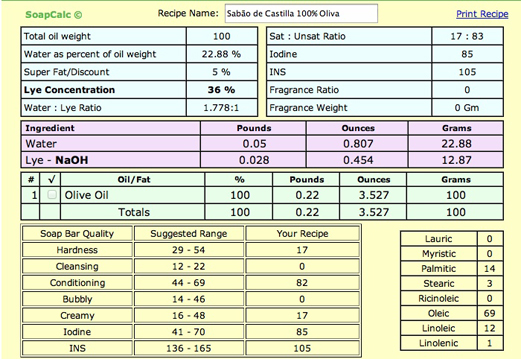 The Mendrulandia the less critical, points out the shortcomings of foam and persistence at the lower limit and hardness and cleanliness halfway from ideal.
The Mendrulandia the less critical, points out the shortcomings of foam and persistence at the lower limit and hardness and cleanliness halfway from ideal.
The Mendrulandia the less critical, points out the shortcomings of foam and persistence at the lower limit and hardness and cleanliness halfway from ideal.
This three years soap has a good hardness but not enough to be a stone-like hardness, pressing hard enough to sell, but gives no breaks. The hardness is somewhat lower than conventional soap with olive, coconut and palm with the same drying time.
The foam remains difficult development and small and very easy soap dissolves on contact with water leaving some cream on the surface of the soap.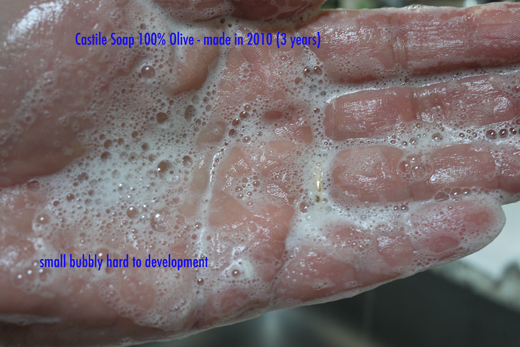
Compared with a conventional soap with olive, coconut and palm notice the big difference in the type of foam, large, abundant and easy development.
How is the soap after use.
What we can conclude is that, despite the long drying time and storage, the soap Castlla 100% olive made by cold process there is an improvement in the properties hearing over time.
Despite these shortcomings Castile Soap 100% Oliva by cold process, this soap is still unbeatable for sensitive skin and is widely used for bathing babies and children, for their high power conditioner.
Protegido: Shaving soap by cold process
Analysis of palm free soap formula
It has been commented on in soap group of Portugal, relevant issues of the negative impacts of cultivation and extraction of palm oil, made from a non-sustainable, socially incorrect by the world’s largest producers, Indonesia and Malaysia.
I had already commented on this issue post – “Palm oil can be sustainable?”: http://www.japudo.com.br/en/2013/01/01/can-palm-oil-be-sustainable/
People more mobilized want to ban the use of palm oil in handmade soap and both seek alternative formulations that do not contain the palm. It is perfectly possible to make a formulation without palm, palm remembering that is rich in palmitic acid and stearic acid rather than the acids are saturated giving the required hardness to the soap. The rule then is to seek butters and oils that are high in palmitic and stearic.
There are no many options and usually expensive compared to the palm. They are, cocoa butter, shea butter and rice bran oil.
Ana Caseiro Duarte Costa soaper from Saboaria group soap posted a link from the site of Amanda Griffin soaper, where she explains very well the issue of palm and also presents five alternative formulation of palm free.
I was curious to know what would be the impact on costs of replacing palm for these more expensive raw materials.
I contacted Amanda Griffin and she kindly gave me permission to publish these formulas here on the site.
Amanda’s website is: Http://www.lovinsoap.com/2012/06/palm-free-recipes-day-1/ # comment-3816
I did the analysis and the result shows a large impact on costs. Reaches almost double the cost and the best of the alternatives, the cost increase is 57%.
This same analysis done for the conditions of Portugal and there is also a strong impact in general.
Our luck is that Brazil is the 7th producer of palm oil and different other giants of Asia, our production is done in a sustainable and responsible through the serious work done by the largest company headquartered in the state of Pará
If someone wants the complete spreadsheet, please contact me.
Simple soap mold
Many already has its mold they use and are satisfied with it.
However people who are starting have some difficulty getting or make them.
I designed this simple mold whose dimensions are 300 x 90 x 100 mm that allows 12 bars of soap 130g in standard size of 90 x 60 x 25 mm. For this standard size 12 bars the soap mass required is 1560g. As has a height of 100mm, allows taller bars, limited to 85 mm.
If want to make a cutting guide for cutting the soap with a knife or blade or a stainless steel wire stretched, has a drawing of how the grooves in the mold.
If you want a smaller mold, just resize the horizontal parts, for example, for 6 bar measurements are by half.
The photo posted above is a old model, has only one difference in the side piece.




 You can download pdf document on downloads page – click here
You can download pdf document on downloads page – click here
Soap mold lining
This reusable mold lining I used for a long time, is made of plastic sheets in A4 size they use for wrapping papers. Can be used for the acetate or polypropylene, these being the most resistant. Can be found at stationery stores or making photocopies and binding. It has a small mass problem sometimes stick a little jacket, but nothing that compromises the finish of the soap bar. To reuse simply wash and dry.
It has a small mass problem sometimes stick a little jacket, but nothing that compromises the finish of the soap bar. To reuse simply wash and dry.
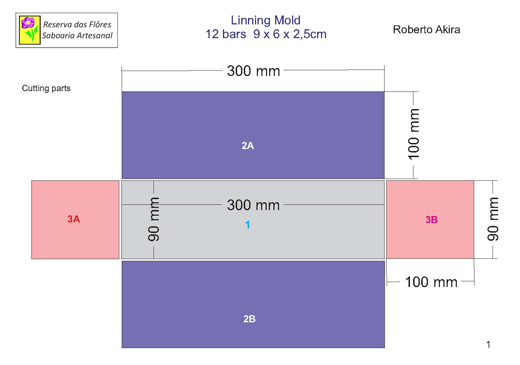

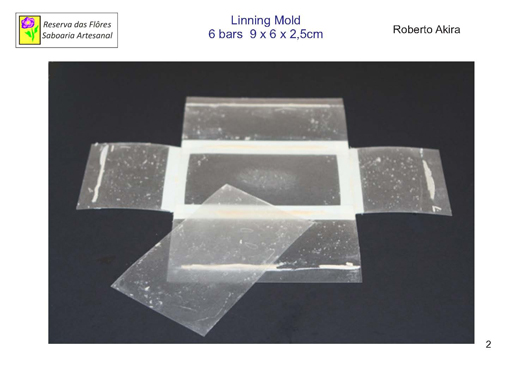
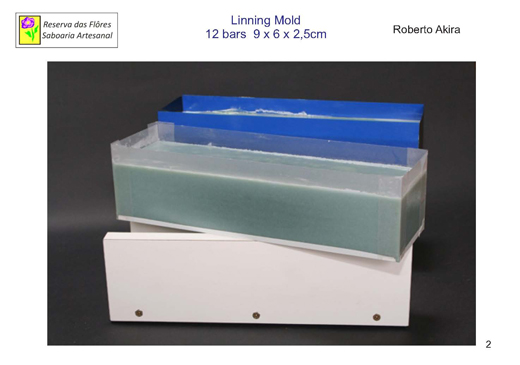
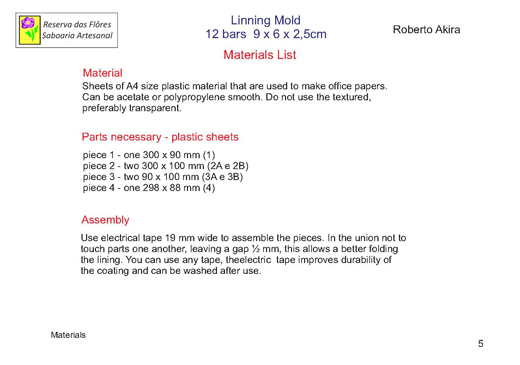 You can download the pdf document on downloads page – clik here
You can download the pdf document on downloads page – clik here
Protegido: Vegetable shaving soap and cream
Homemade laundry soap powder
Discussion group Saboaria – Portugal
I did this formula for homemade laundry soap to post at Facebook group to discuss the soapmaking in Portugal.
This group is fabulous in its spirit of sharing knowledge in a transparent and unpretentious, all learn and exchange knowledge.
Those interested in accessing the group, is closed and need to request membership, the address is: http://www.facebook.com/groups/saboaria/
In Portugal ecological awareness and sustainability is rapidly developing. People worry about the economy and preservation of natural resources, recycling and using environmentally friendly products.They are always looking for products that can replace industrialized products derived from petrochemicals.
In the soapmaking group someone requested a recipe for laundry soap. I suggested a vegetable coconut soap that usually I do: coconut / palm – 75/25, but as the coconut oil is expensive in Portugal, made a modification to match costs and availability, without sacrificing too much in the performance of soap. The common extra virgin olive oil in Portugal is cheap, around $ 7.40 a gallon. The formula of the original coconut soap and modification are on the download page.
From this soap bar was derived the soap powder because many have the custom to grate the soap and dissolve in water and use the washing machine. The liquid soap thus prepared is very thin and needs to be shaken before use.
Because I not have the coconut soap bars, I make a successfully process using a lavender soap bar whose composition is the closest to the my formula of coconut soap bars. The composition of my basic soap is: olive / coconut / palm / castor: 30/30/35/5. If everything went right with this formula, sure will look better with the original or modified formula of coconut soap bars.
Formula
The coconut soap bars, as said above, can be the original whose composition is: coconut oil / palm oil – 75/25 or the modified (Portugal) version whose composition is: coconut oil / palm oil / olive oil – 60/10/30. Remember that the dynamic of cleaning is soap solubility and power to make foams. Thus, the greater the amount of sodium palmitate, one of the more soluble soap salts and also the soap that makes more foam, the higher the cleaning power.
Soda washing softens the water and removes dirt and borax is a bleach and strip odors.
It takes a kitchen grater to grate the soap bar, scales, and a food processor.
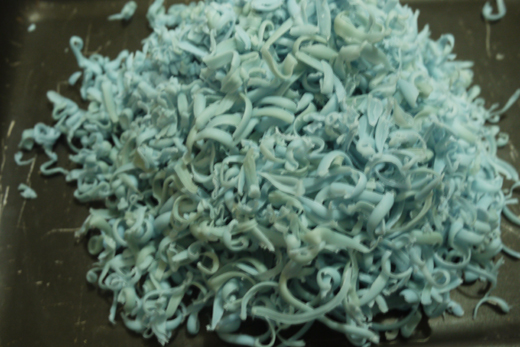 Here the grated soap in the kitchen grater. Grating previously facilitates grinding in a food processor.
Here the grated soap in the kitchen grater. Grating previously facilitates grinding in a food processor.
Sodium carbonate and borax is weight in kitchen scale.
In food processor, will gradually adding the grated soap together with small amounts of sodium carbonate and borax, and powering the processor to obtain a fine grinding. As it is a mixture of solid gradually make processor to preserve of the over-heating.
The colored facilitate observing the homogeneity of the mixture. When the mixture is very fine and very homogeneous soap powder is ready.
The soap powder and dissolving in water. Obviously the dissolution of this soap can not be compared with synthetic industrial and petrochemical soap powder. This homemade soap takes longer to dissolve but the mechanical work of agitation in the washer is enough for a good dissolution and washing.
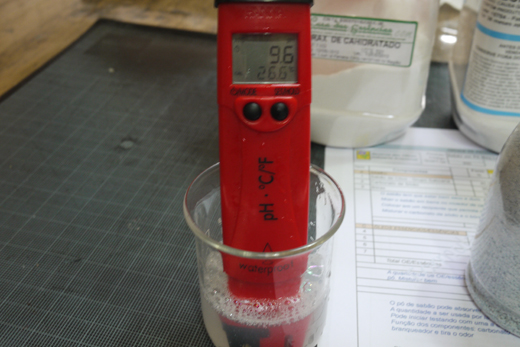 Measure the pH of homemade soap powder. Borax acts buffering the solution and maintaining the pH below 10.
Measure the pH of homemade soap powder. Borax acts buffering the solution and maintaining the pH below 10.
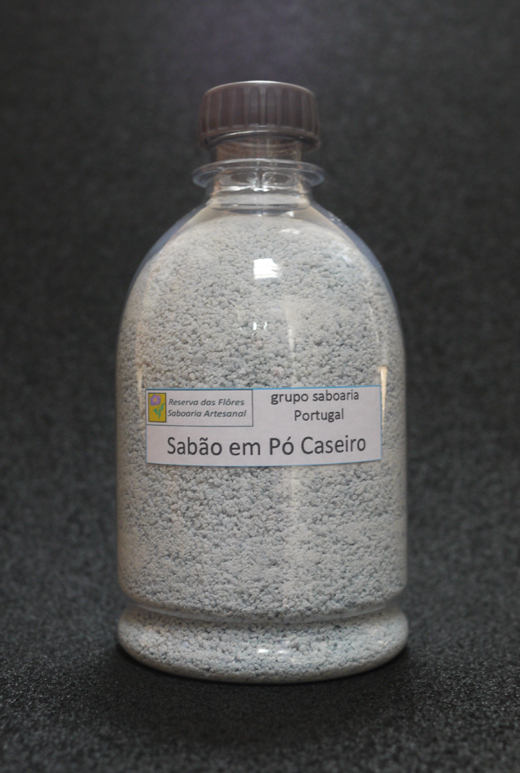 clik here to download soap powder formulas
clik here to download soap powder formulas
What to use to color the cold process soap?
Three features should be considered in the choice of materials to give color to soaps made by cold process. The coloring materials must first be inert to the skin, i.e. must not cause any adverse reactions in contact with the skin. Must be resistant to alkaline saponification reaction of the cold process and should be light resistant, must not fade and lose the color when the soap is exposed to light.
To meet the first requirement, the best option is to use materials approved by the FDA (Food and Drug Administration) U.S. for use in cosmetics. Combining this with the others requirements, there are few alternatives and usually fall in the class of pigments, most inorganic and synthetic.
• Iron oxide – black, red, yellow, ocher
• Ultramarine – dark blue, light blue and violet
• Chrome oxide – light green and dark green
• Titanium dioxide – white
• Zinc oxide – white, light red (calamine)
• Ferric Ferrocyanide – Dark Blue
• Mica – pearlescent effect of various hues
These class of pigments are those approved by the FDA are resistant to cold process and will not fading with time.
These pigments are hard to be found in small quantities that are used in soapmaking. An alternative that I use is to buy these pigments in shops selling art materials – the painters use to prepare their paints. They are sold in small packages, less than 100g, costly but yield much but you can buy sharing with other crafters. I use of trademarks Sennelier (French) and Mahler (fractionated in Brazil).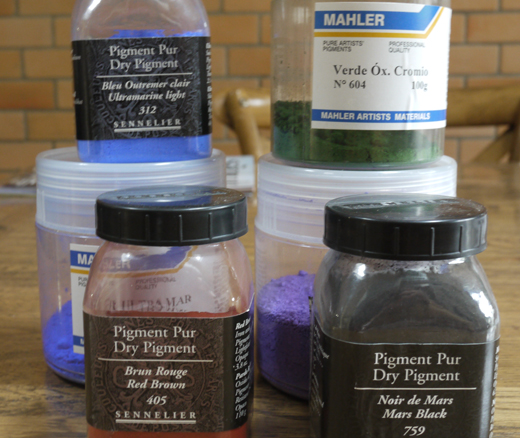
Besides these pigments can be used clays that have no tinting strenght as pigments but are easy to be found in the colors white, green, yellow and pink, these two latter mixed in its preparation, with iron oxide. For black color option you can use of bamboo charcoal that besides the strong tinting strength has its skin conditioning properties.
Another option is to do your own coloring, by maceration of certain plants with oils that are commonly used in cold process. An example is the macerating green tea or herbal mate to obtain a light green color. Some components of the formulation itself may give a slight color to your soap, as the honey will give you a cream or the use of goat milk that depending on the cold process temperature can give a cream or dark brown or ocher.
Important to emphasize that most dyes which are used in food and coloring candles are anilines (azo components) that are not resistant to alkali and also has not resistance to light and hence should not be used to impart color to the soap. In this case it is always good to test before.
A final observation concerns the question of natural versus synthetic pigments. If you are a nattural soapmaking and waives only use materials of natural origin, it is understandable that you will not use a synthetic pigment (man-made). Turns out the FDA approval only synthetic pigments because the natural may be contaminated with heavy metals (toxic) that can not be separated in their extraction and actually do some harm to health, such as lead and cadmium. The choice is yours!
On the download page I put files with a list of materials approved by the FDA for use in cosmetics and also the catalog of artistic Sennelier pigments. In both are marked pigments that can be used in cold process.
Lasting of cold process soap
An important property of a soap made by cold process is its durability in use. A good handmade soap formulated with a suitable balance of oils can be used for a long time, much more than an industrialized soap. Soaps spending fast, softens in contact with water, that are slimy, has not good acceptance. The main component which provides hardness and durability is palm oil (palmitic acid) and a lesser degree, coconut oil (lauric acid), which are so-called hard oils.
 This lavender soap lasted 20 days with an average of three daily baths, used by two people. Remained full until the end, placed in a soap dish with good water drainage. In its formulation has the following composition: olive / castor oil / babassu / palm – 30/5/30/35 and superfatting of 5%.
This lavender soap lasted 20 days with an average of three daily baths, used by two people. Remained full until the end, placed in a soap dish with good water drainage. In its formulation has the following composition: olive / castor oil / babassu / palm – 30/5/30/35 and superfatting of 5%.

